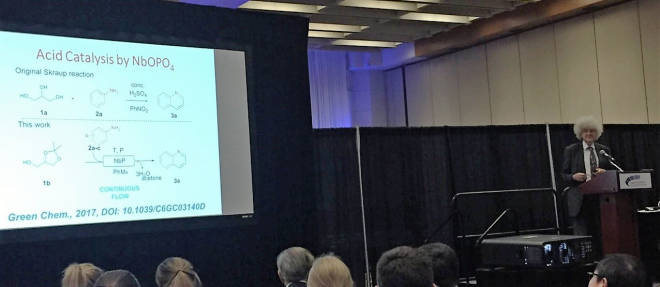By Kevin Szkop and Alex Waked
This year, the GCI partnered with the Chemical Institute of Canada (CIC), the organizing body of the CSC2017, to be closely involved in various aspects of Canada’s largest chemistry meeting.
In collaboration with GreenCentre Canada and CIC, the GCI organized a Professional Development Workshop as part of the CSC2017 program. This event consisted of four components:
The green chemistry crash course, led by Dr. Laura Reyes. Laura is a founding member of the GCI, and is now working in marketing & communications with GreenCentre Canada.
A case study, led by Dr. Tim Clark, Technology Leader at GreenCentre Canada. The case study gave attendees a unique opportunity to learn about some projects that GreenCentre has been developing and in collaboration with peers, learn how to find applications for new intellectual property (IP) and how to make contacts within relevant companies.

Dr. Tim Clark leading the GreenCentre Canada Industry Case Study
Career panel discussion, sponsored by Gilead, featuring members of academia and industry.
A coffee mixer for an opportunity for informal networking.
Supplementary to the Professional Development Workshop, the GCI organized a technical session, co-hosted by the Inorganic, Environmental, and Industrial sections of the conference. This new symposium, entitled “Recent Advances in Sustainable Chemistry”, brought together students, professors, industry, and government speakers to showcase a diverse and engaging collection of new trends in green and sustainable chemistry practices across all sectors of chemistry. Highlighted talks included Dr. Martyn Poliakoff from the University of Nottingham, also a CSC2017 Plenary Lecturer, Dr. David Bergbreiter from Texas A&M University, and Dr. William Tolman from the University of Minnesota.

Dr. Martyn Poliakoff teaching the audience about NbOPO4 acid catalysts found in Brazilian mines
Dr. Bergbreiter’s lecture was an engaging one. His enthusiastic approach to the use of renewable and bio-derived polymers as green solvents was captivating to both industrial and academic chemists.
Dr. Martyn Poliakoff, a plenary speaker at the conference, gave a phenomenal talk during the first day of the symposium. His charismatic style complimented perfectly the cutting-edge research ongoing in his group at the University of Nottingham. Particularly interesting was the use of flow processes in tandem with photochemistry to yield large quantities of natural products useful in the drug industries.
Dr. Tolman’s talk was of interest to essentially anyone working in an academic environment, especially for student run groups, like the GCI, with both academic interests as well as safety awareness initiatives. In the first part of the talk, synthetic and mechanistic studies of renewable polymers were discussed. The second part shifted focus to student-led efforts to enhance the safety culture in academic labs, which stood out from most of the other talks in our symposium.
One highlight was a group of graduate students at the University of Minnesota organizing a tour of Dow Chemicals to observe the work and safety codes in an industrial setting, which they used as a lesson to bring back to their own research labs. This caught the eye of most of the GCI members, which inspired us to organize a similar day trip in the future.
In further efforts to make our symposium accessible to undergraduate and graduate students, the GCI partnered with GreenCentre Canada to award five Travel Scholarships to deserving students from across Canada to provide financial aid to participate in the conference.
We thank all of our speakers, both national and international, for their participation in the program. It was a great success!


